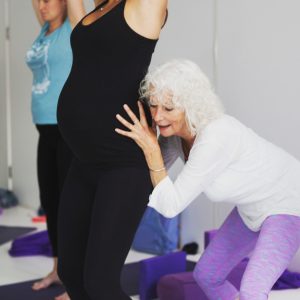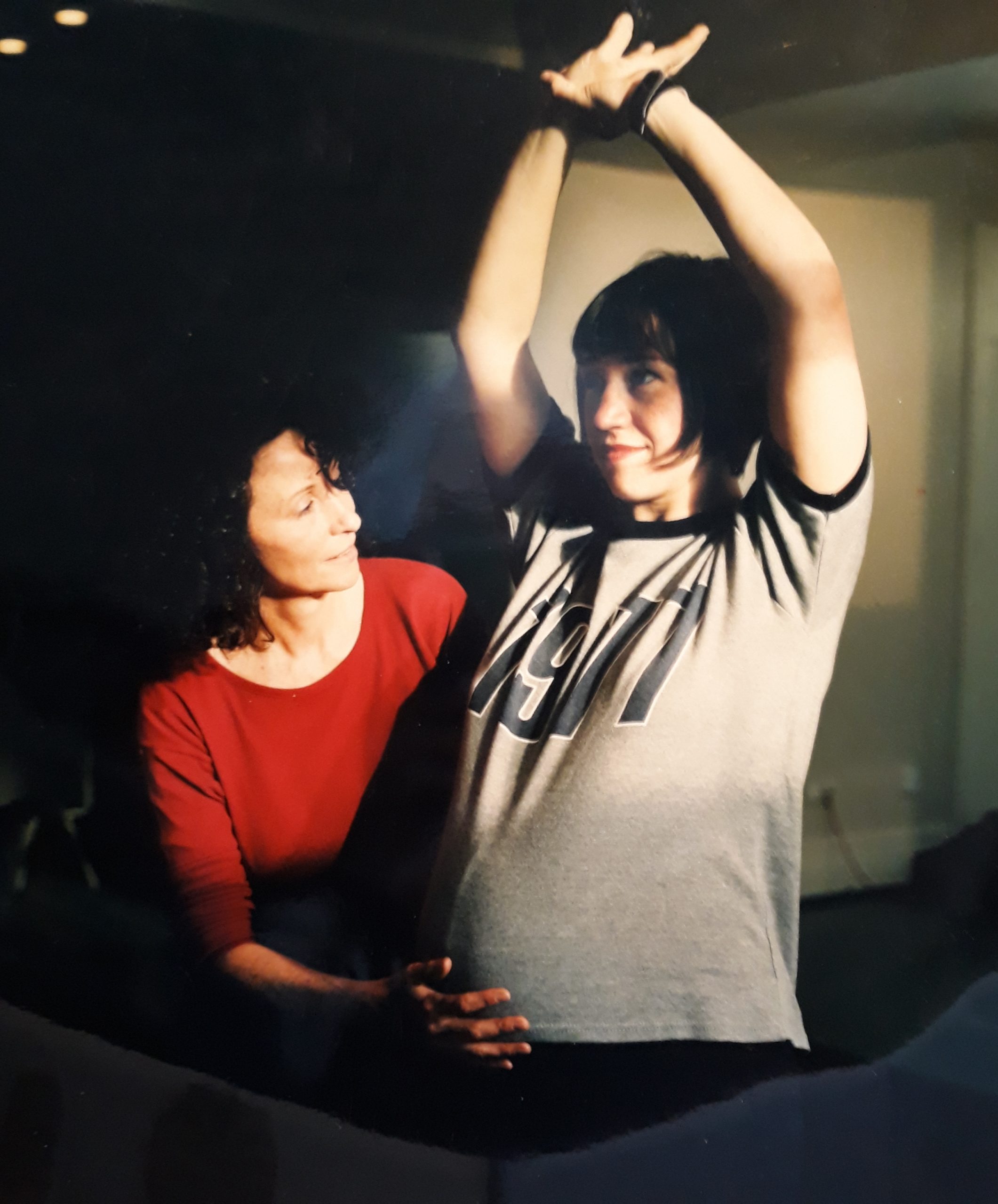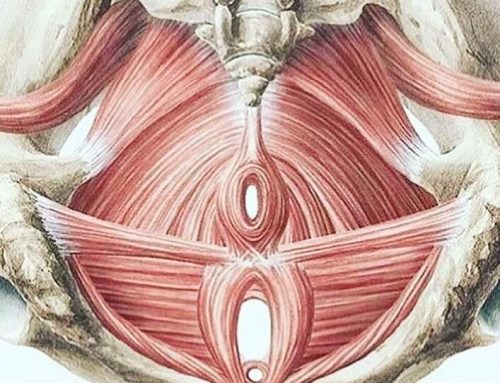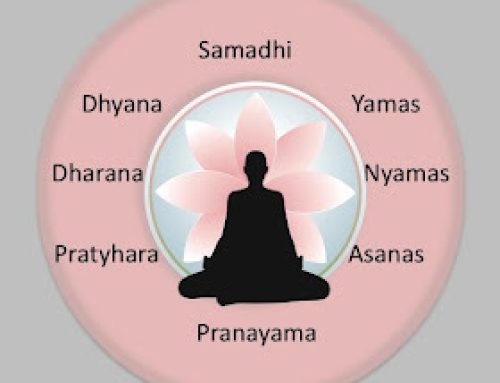In West London, where I lived through my first unplanned pregnancy, Lolly’s reputation preceded her. It was the early nougties, and pregnancy yoga was new and exciting. I had just discovered Janet Balaskas and the Active Birth Movement, bought the book and tried to find a Lolly class but to no avail.
It was not until baby number 4, sixteen years later, that the stars aligned, and Lolly was teaching a pregnancy yoga class on the Kings Road just over the bridge from my Battersea home. I could finally meet Lolly Stirk and take a class with her.
She was as lovely in person as her reputation suggested, and we have been in contact ever since. Interviewing Lolly was fascinating because she gave real insight into how much yoga has changed since the days of Iyengar.
How do you think Yoga for Pregnancy has changed?
I can only really talk for myself and colleagues at YogaBirth to answer this question. Over the 40 years I have been teaching and training, my work has developed and deepened considerably. When I first started, I was adapting and refining my Iyengar training to suit the softer, rounder and feminine pregnant body as well as introducing the principles of Active Birth as in all fours, squatting etc. It was a bit clunky to begin with back in the 80s but the more I taught the more refined it became. John my husband is an osteopath as well as a yoga teacher and a lot of what I brought into my work was founded on sound osteopathic principles that I learnt from him. And then meeting with Vanda Scaravelli brought in another dimension which was exciting as we began working from the inside out. I am constantly honing away and adding new ideas to my work. Obviously, pregnancy yoga is very popular these days which is wonderful but, in my opinion, working strenuously with pregnant women is counter-productive and only takes energy from the growing baby and can harm the pregnant woman’s body.
What’s so special about teaching pregnant women?
I became interested in teaching yoga to pregnant women after my own pregnancy and birth. It helped me get through the discomforts of pregnancy and during labour and birth it led me, so I felt compelled to pass it on. I have devoted my career to developing and teaching for that reason. I never tire of it. Pregnant women are already in an altered state; they are halfway there; their senses are heightened. They are so much less in their rational than their primitive brain. We are working with people who are in an ancient process and if you can tap into that you can take them deeper. Teaching yoga is about revealing something that is already there. We are giving them the space to open the door to their instinctive self and giving them the confidence and trust to walk through that door and explore. Trust is the key word. Their minds are so busy and confused and frightened by everything around them; all the horror stories they get told, the films where birth is portrayed as dangerous and awful and the medical information and choices they have to make. So, during the class you slow them down, connect them to their breathing, their bodies and to their babies and the wisdom is revealed. Yoga in pregnancy is partly about slowing women down enough to feel the yoga, the connection between body and mind. The breath and the postures are a way in. Michel Odent says that midwives are born, not trained and I think it’s the same for Pregnancy Yoga teachera… it’s an innate skill.
So what’s the essence of a YogaBirth Class?
YogaBirth classes are multi-layered. The breath lies at the heart of every class. When Vanda Scaravelli was asked why we do postures, she said because we like doing them! But without the breath it’s just gymnastics. What makes yoga mindful comes from using the breath in the postures to illuminate what you are doing. It deepens the connection. We ask women to tune into their resistance, stiffness if you like and rather than tense up to it, use the breath to relax into it, and let go of it particularly through the exhalation. This is the best preparation for labour. Some of the postures and movements we make during the class, for instance rocking and rolling our hips on all fours may be comforting during labour so we suggest possible ways of using our bodies during labour but not as a formula… Always follow what your body tells you. Part of the YogaBirth way is to have a circle at the beginning of class, to meet and discuss over a cup of tea and biscuits. Sometimes I will introduce a subject, give a mini-lecture and answer questions. Sometimes a mother who was part of the class in her pregnancy comes back with her baby to tell her birth story and how it is being a mom. Horses mouth information… and this way we build community. Many women meet their friends for life at class and the children grow up friends.
What did you get from your time with Iyengar?
I was born in South Africa and when I arrived in London in 1969 at the age of 19 the first wave of interest in Yoga was happening, the Beatles were visiting the Maharishi in Rishikeshand, it was all very groovy. I was part of a group of people orbiting around R.D.Laing, the anti-establishment psychiatrist; an extraordinary man and he turned us onto yoga. Luckily, we found Dona Holleman, an incredible teacher who was Mr. Iyengar’s right hand woman and a complete devotee. We started training with her and when Mr. Iyengar came to London we took classes with him. It was a bit like joining the army. It was very disciplined. So, with all the freedom and love going on around us we were at the same time being very disciplined! I had never been sporty, I was a softie, always in the reserve team at school and, suddenly, here I was using my body in a very disciplined way; practising headstands and shoulder stands for 25 minutes at a time and performing 80 backbends from standing — one after the other. It was an extraordinary time, I learnt so much and I’m really grateful for it. Sometimes when I look back, I wonder how my body could stand such rigorous training… But I was young.
The way I was trained you separated the postures from the breath work. First you practised physical postures, letting the breath alone and then you did Pranayama at the end of the session. I know I held my breath a lot during the strenuous postures, but somehow, I didn’t injure myself and learnt a lot about endurance.
What kept drawing you back to such a strenuous demanding practice?
Well, I obviously loved it. The physical and mental challenge was intriguing. And the group of people I was involved with were all discovering yoga together, so it was a collective experience. When Dona left to go to Italy, we found other teachers who brought different elements into the work and took a softer less military approach. I studied for a while with Angela Farmer who had a gentler way of working and Mary Stewart an amazing woman was my teacher for many years. Mary introduced me to Sandra Sabattini, who took me to meet Vanda Scaravelli and my path took another direction as I continued to develop my work with pregnancy.
How did your time with Vanda Scaravelli and Sandra Sabattini change your yoga practice?
When I went to Italy to study with Sandra it was a real turnabout, suddenly I was practising yoga from a different angle, from the inside out. I was resistant to it at first, because I had invested so much in my Iyengar training. Sandra took me to classes with Vanda, who was writing her now famous book, ‘Awakening the Spine’, at the time. She drew our attention to gravity and the breath during the postures. That became the focus. This was almost the opposite to my posture focused training but slowly, slowly it started crossing over and my body really liked it. The most exciting element was how appropriate on every level it was for pregnancy. Over the years I had adapted the Iyengar style of yoga, softened it, made it more feminine but still it was a bit like fitting a round peg into a square hole. This way was made for pregnancy. I was very flattered when Vanda heard that I specialised in pregnancy and postnatal yoga and was part of the Active Birth Movement she became very animated about pregnancy and birth and said to me ‘Tell them it is the most natural thing on earth’. Once when I arrived for a session at her house near Florence she showed me a photograph of the hieroglyph of the word for Birth. It was Cleopatra half kneeling, half squatting giving birth. Vanda said to me, ‘You see, she did not lie down’. She was a woman of few words Vanda but when she paid attention to you, you glowed all day!
Tell me a little about your own pregnancy and homebirth?
In the seventies when I gave birth hospital births were very controlling. The maternity services were introducing a highly medicalised approach to childbirth which they called the Active Management of Labour. This meant that no labour should last more than 12 hours. If you didn’t dilate at 1cm per hour they intervened. It was real conveyer belt birth and I didn’t want to give birth that way. Luckily, I found an independent midwife who I will never forget. It cost £34.00 to employ her and I remember thinking what a lot of money that was. I gave birth at home in our flat in London with John, my husband, my childhood friend Meloma, my two cats and my midwife. It was the perfect team in a familiar environment. Although it wasn’t an easy birth, my daughter was in the posterior position, we managed. I did at times think… please can I have an epidural now… but I was so pleased afterwards. When the time came, and she was on her way out I squatted down on our bedroom floor and out she came. It was joyous. Having read the book by Frederick LeBoyer, Childbirth without Fear, we had a warm tub of water ready to welcome her into the world. LeBoyer believed babies needed a gentle welcome into the world and a warm tub of water reminded them of the womb. It certainly calmed her down. I had never done anything so real in my life. The experience opened my eyes and did transform me. I felt so proud of myself and in love with my daughter and my team. The breath was my guide, it led me through the waves, kept me calm and I wanted to pass it on. Her birth really was the springboard into my career
So how did your own birth experience inspire you as a teacher?
I was teaching general yoga during my pregnancy and after giving birth I wanted to learn as much as I could about pregnancy and childbirth. I’m still not sure why I have such an interest in this area, but once I started, I couldn’t stop. Again, as in my yoga studies, I found the best Childbirth Educators to learn from. I studied with the NCT and had Sheila Kitzinger as mentor. Sheila was an anthropologist and has written around 22 books on Childbirth and Pregnancy. Her enthusiasm and charisma were infectious. Over the years I learnt so much from her. I also started following and going to lectures by Michel Odent the famous French Obstetrician. Everything he said made such sense to me. He has such a depth of knowledge which made it simple. As a doula I attended a few home births with him in and that’s where I learnt the most about being at births and not interfering with the process. He really instilled that into me.
How did you meet Janet Balaskas and get involved in the Active Birth Movement?
Janet was in my social circle and became a friend. She was an NCT teacher and I did most of my childbirth education training with her. She is inspirational and this led to the creation of the Active Birth Movement. Her reaction to the introduction of the Active Management of Labour was to say, ‘What about Active Birth?’ and that really led her onto writing her book. We looked at ancient drawings and etchings of birth scenes from all over the world and most of the women throughout history were squatting. We began to look at the dynamics of squatting and upright birth and began to bring elements of this into our yoga classes, encouraging and educating women on the physiology of Active Birth which made such sense. Then one of Janet’s students refused to lie down in labour at the Royal Free Hospital and an obstetrician made her sign a disclaimer form during her labour. We organised a rally in protest. It was a wonderful day with around 5 to 6 thousand people marching on Parliament hill with banners saying things like ‘Stand and Deliver’ and ‘Birth not Extraction’… Sheila Kitzinger and Michel Odent and Janet spoke and there was music. It was the birth of the Active Birth Movement. Not long after I joined Janet on The Active Birth Teacher Training Course as Director of Yoga and for 14 years, we trained Active Birth Teachers who were a combination of Childbirth Educators and specialised yoga teachers. It was unique, cutting edge and captured the zeitgeist of the 80s and 90s. Some of the women we trained are now the Directors and tutors on the YogaBirth teacher training course, so this knowledge continues.
It’s interesting to notice that the divergence that was happening in yoga with Angela Farmer, Sandra Sabatini and the burgeoning pregnancy movement was the same divergence that was happening in childbirth with the Active Birth Movement?
Yes, it was the time of Womens liberation, burning your bra and carrying placards and things began to change in all walks of life. It was very exciting, and many changes were made but it did eventually settle down and peter out. I think one reason for that was that people were more comfortably off, so people softened. But in the birth world many of the results of those times are still with us… freedom of movement is a policy in all hospitals not like in the 70s when we were confined to bed and the birth centres at many major hospitals sprung up in the 80s and 90s due to the dynamic work of midwives, in particular in London Pauline Cooke who was responsible for the birth centres at Queen Charlottes and St. Marys hospitals. I do occasionally remind women in my classes that the birth centres they perhaps take for granted took a lot of campaigning and effort to create. And now with this recent wave of unrest issues that need to be addressed are bubbling to the surface. It’s a very good thing and time again for a surge of change.
As independent community birth workers what we can we do in our classes to empower women and prepare them today to stand up to this suffocating system?
Just keep on keeping on. I think we are all doing a great job in our communities and slowly surely, we have made changes. At times it is disheartening and feels like we are walking backwards, but its two steps forwards one step back. Quite recently there has been a big change in the way the third stage of labour is managed in hospitals. The cord is being left alone to pulsate, allowing the baby the extra blood and stem cells that nature intended it to have and we have been campaigning for this for many many years. It takes time and all we can do is keep informing and educating till it is heard. I don’t think we will be going back to anything as controlling as the active management of labour, but we can’t get complacent. Onwards and upwards.
Can you talk a little about hypnobirthing? Having come from a background of Yoga how did you find the hypnobirthing movement? Does it offer something different?
Yes, I studied hypnobirthing with Katherine Graves and learnt a lot. She is a wise and inspiring woman and has enabled so many women to give birth without fear. Many of the elements of hypnobirthing are already present in our yoga classes. We have been using affirmations and subliminal suggestions during class since we started teaching specialised pregnancy yoga and the power of these words and affirmations are beyond doubt. Many of my colleagues and I have had women from our classes reporting back after they gave birth that during their labour, they heard our voices. We slip into their subconscious with our voices and when they needed us, there we are! After months of repetition in our classes in simple, gravity assisted positions there we are!
What I found difficult in the hypnobirthing course was the lack of the physical. The mind is powerful, words are powerful and when you bring in the physical, I believe you are giving women really powerful tools to work with the process of labour and birth. It is after all a physical process, definitely led by the mind, but there is also the physical element that can be encouraged. Generally speaking, people are far less naturally physical than we used to be and bringing a physical element into the work is magic.
The other element that didn’t sit too well with me was the breath work in hypnobirthing. I know it is very helpful for many women, but for me it is too formulaic, too technical and not the way I choose to work with the breath. I call the way I work with the breath in my classes ‘Hypnobreathing.’ This way of working with the breath is a way of letting go to the process and not something to hold onto.
When you look forwards how do you see pregnancy yoga evolving? There is so much female power rising now. How do you think it will influence pregnant women?
I look forward to more and more women coming across yoga classes that tune women into the possibility of giving birth with less fear, more with excitement and open mindedness. Until about 10 years ago I had only held classes in my own name, so women knew what I was about when they came to my classes. I then joined Triyoga and started teaching under their banner in Chelsea. Women would walk into class and for some I was a surprise. I had to work harder to open women’s minds up to the transformative possibilities of giving birth. Many women come once and don’t return and I accepted that, but many did and it was such a pleasure to hear many stories from women who were ‘no way’ going to give birth without pain relief, or even have elective c/sections, having water births with the assistance of doulas and feeling exhilarated after. Freedom of choice is a wonderful thing.
Lolly, tell me a little about YogaBirth
Our strapline is ‘Approaching Birth with Love’ which I think describes us beautifully. We are an organisation of specialised yoga teachers and childbirth educators who work with women over the perinatal period. Our roots go back to the days of Active Birth and the directors and tutors of our training course as I said earlier were trained back in the 80s and 90s so bring the knowledge and ethos with them. Some of our members are midwives and doulas and complimentary health therapists and combine this with the work. We meet up regularly at Study Weekends and Days where we employ experts in all fields of Childbirth and excellent yoga teachers to come and teach us and keep us updated. We have a support network and are always asking advice from each other on our facebook group. Our training course which is accredited by the Royal College of Midwives takes 18 months, and it is thorough. The women in YogaBirth are my yoga family. I see myself as an Elder.

Image by Sarah Stirk
To find out more about Yogabirth please visit: https://www.yogabirth.org
To find about more about Lolly Stirk’s teaching schedule and upcoming workshops please visit: http://www.lollystirk.co.uk






